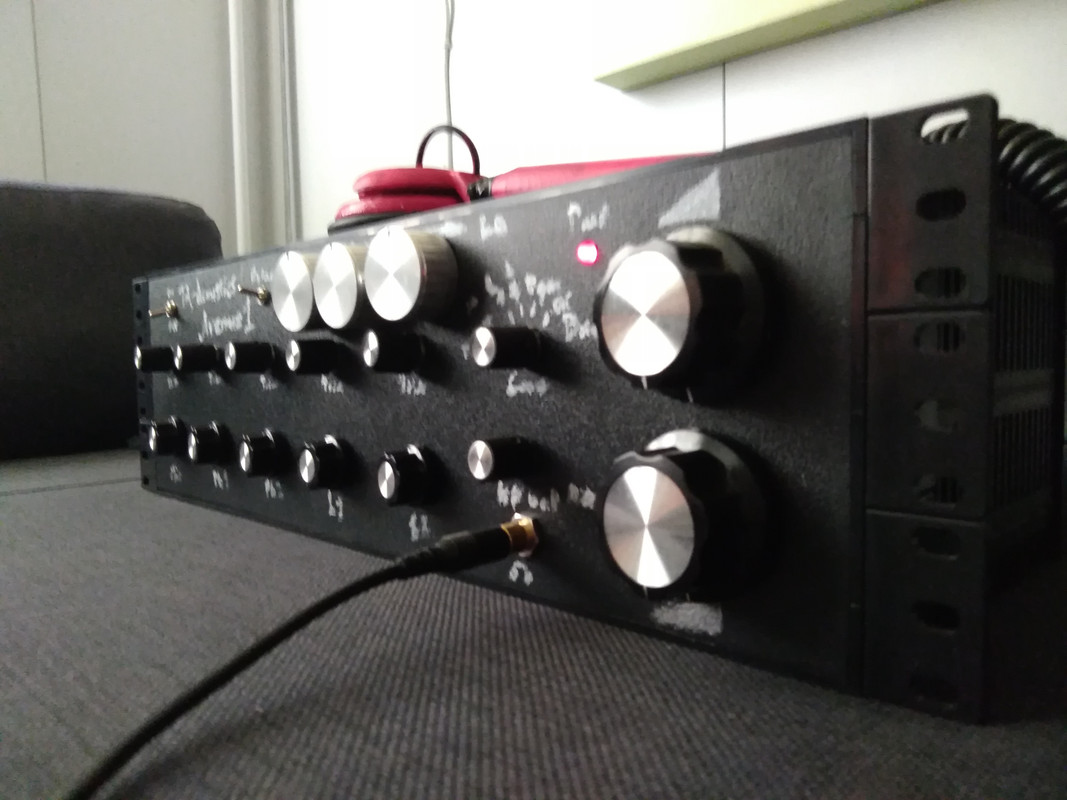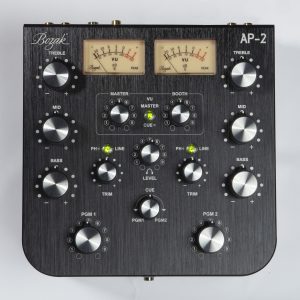So you have heard about rotary mixers, but have no idea how to use one and what all the knobs are for? I made a short video that shows you exactly how I use my Bozak.











So you have heard about rotary mixers, but have no idea how to use one and what all the knobs are for? I made a short video that shows you exactly how I use my Bozak.
Interesting.
Bascially you have no cue level (or master level, unless you buy something like that fancy-pants meter) monitoring, and have to do everything by ear.
Also 80% of the mixer is not touched
A lot of money to pay for 2 quality knobs...
It really is flying by the seat of your pants.
Still, you make it sound smoother than most other mixers.
Respect!
bored, curious, deaf or just bad taste in music?
finally a mix by me
and what's this, another shoddy mix...another dull mix
From what I read the "problem" with old school rotaries is that they don't have gain control.. you'd play the input channel at roughly 6-7 and the rest was the gain.
Then at low/moderate listening volume you'd keep the master level at 3-5 and at peak hours operate it at around 7-8 which is the system unity gain or 0dB.
This type of configuration leaves a lot of headroom.. I read the Bozak mixers had quite an impressive THD&SNR, headroom and dynamic range even by todays standards, ie. basically they wouldn't clip the rest of the system at high volumes (even at 9-10) as they were capable of providing very clean output at high volumes with long cable runs etc.
On top of that people claim they have far superior low frequency response than any other mixer (the Urei is said to sound "harsh" in the high frequencies, newer Formula Sound mixers are considered sounding transparent)
Originally the mixers were designed for field recordings; if you've ever seen a movie from the 50-60's with distorted, overdriven-kind of like speech and musical passages you know what I'm talking about, in case you haven't you could watch an old spaghetti western from the era. This was before foley and post-production.
However Bozak, and later Urei, were the first commercial "disco" mixers capable of mixing more than 2 channels. The first was the mixer known as "Rosie" by Alex Rosner who did it upon request for Francis Grasso (Rosner's work influenced parts of system in Paradise Garage for example) who pioneered and invented techniques such as beatmatching and slip-cueing.
Later on the mixers were adopted by broadcast studios where the output had to be high in order to meet the demands of the RF equipment and technology that was available at the time, in lay terms you'd play music that was encoded to AM/FM and fed to RF amplifiers which could've been 5, 10, or even 30m away from the mixer for radio broadcast antennas which leaves little to no room for error since the noise floor is amplified in the same process.
Many complain the lack of metering, channel gain, split cue etc.. the Bozak had mono EQs which aren't suitable for todays mixing styles either, I believe they were there for slight correction.
So it's more of a "thinking man's" mixer.
EDIT : I remember reading (I've seen the schematics but never paid attention to it) that the Bozak had in fact unbalanced master outs.. some expert like Buzzy Beck, Mario G or Shorty could verify this (I think Buzzy Beck passed away a few years ago though)
EDIT 2 : this is a forum for DJs so I figure there are a few members who own/have used one.. iirc Kevin James had one but switched it to a Rane 2016
EDIT 3 : I find this subject interesting because I built a 3RU 19" rotary mixer a few years ago and was planning on making one from the ground up, ie. preamps and everything

Last edited by efinque; 02-24-2020 at 04:59 PM.






There were also Russco 505S which was an early analog mixer used in radio control and production and also mobile DJ's. And the legendary Showco 2600's that were in many clubs. Cerwin Vega had a few out there as well.
Lemme see if I can find some pictures. I had a mid 70's Showco (faders) back in the day, we harvested it out of a sports bar that closed down - left it with an old business partner.
Here's some electrons from back in the day of these classic mixers.
Had the good fortune to see them live in their heyday around 1978.
Last edited by SWS Productions; 02-25-2020 at 09:43 PM.
Wait.. I thought the Biamp SCM-series were the best analog mixers in the late 80's-mid 90's. No per-channel EQs.. very rare, high output etc (Scary G in here had one iirc, the 7600 although it failed on him after several years of use) but very robust.
I just read they had stuff like light show control incorporated into them.. very handy indeed, maybe something mixer manufacturers should learn from. I think Armin van Buuren is one of the rare DJs making clever use of the technology with the Pioneer mixers that have SPDIF/digital I/O, ie. fader-starting two decks simultaneousy; another is audio and the other is SMPTE timecode to the VJ for triggering/syncing visuals, they have a IM (instant messenger, via laptop/RJ45) connection though.
Anyway, sorry for the off topic..
Last edited by efinque; 02-25-2020 at 03:07 PM.
There were SO MANY DJ mixers coming out in the 70's and on...
A lot of them were made for mobile DJ's and cheap places.. a lot of them were real junk.
But before that, there was *plenty* of DJing going on.. but it was going on in radio stations. Here's a Collins 212E, this was from the 1950's.
That Russco console that SWS posted was also made for radio, it was a bit cheaper model probably.. but basically, radio stations being on the air 24/7, the consoles were built to last.. and designed to be easy to repair. For example instead of using a regular potentiometer they used step attenuators, like this:
Unlike a regular fader that even if you cleaned them.. would wear out from constant use, these can just be opened up in the back and serviced back to new in a few minutes.. they will last for decades of all-day-every-day broadcasting. In fact the front panels of those consoles are designed to flip open with a hinge action, while the station is on the air if necessary, to have some work done on them.. obviously you could not just stick your hands right in with the power on (tubes, shocking!), but you could do some things.. and get the station back up in minutes.
So yea, but when discos came on the scene, I am sure that some of them used existing radio consoles, because there were so many of them available.. but end of the day they were very large and expensive, and usually had a lot more input and output options than needed for a club.. so these smaller club models were really the cheap models.. even the rotaries, which we now think of as the expensive mixers, were actually smaller, cheaper adaptations of the ones used in radio stations all along.











So, on the Bozak you can't hear both decks at the same time in the headphones when the switch is on "cue"?











I like the new one, AP-2. Small in size, but comfy distance between channel knobs. Basically all you use on the 6 ch one. The send return could be per channel, though.







Bookmarks